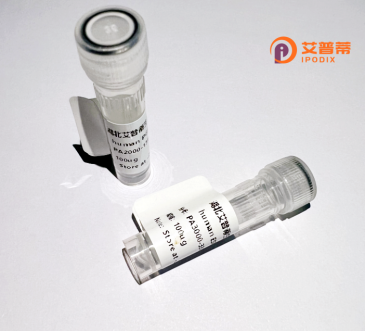
| 纯度 | >90%SDS-PAGE. |
| 种属 | Human |
| 靶点 | CRI1 |
| Uniprot No | Q9Y6B2 |
| 内毒素 | < 0.01EU/μg |
| 表达宿主 | E.coli |
| 表达区间 | 1-187aa |
| 氨基酸序列 | MSEMAELSELYEESSDLQMDVMPGEGDLPQMEVGSGSRELSLRPSRSGAQQLEEEGPMEEEEAQPMAAPEGKRSLANGPNAGEQPGQVAGADFESEDEGEEFDDWEDDYDYPEEEQLSGAGYRVSAALEEADKMFLRTREPALDGGFQMHYEKTPFDQLAFIEELFSLMVVNRLTEELGCDEIIDRE |
| 分子量 | 47.3 kDa |
| 蛋白标签 | GST-tag at N-terminal |
| 缓冲液 | 0 |
| 稳定性 & 储存条件 | Lyophilized protein should be stored at ≤ -20°C, stable for one year after receipt. Reconstituted protein solution can be stored at 2-8°C for 2-7 days. Aliquots of reconstituted samples are stable at ≤ -20°C for 3 months. |
| 复溶 | Always centrifuge tubes before opening.Do not mix by vortex or pipetting. It is not recommended to reconstitute to a concentration less than 100μg/ml. Dissolve the lyophilized protein in distilled water. Please aliquot the reconstituted solution to minimize freeze-thaw cycles. |
以下是关于重组人CRI1蛋白的模拟参考文献示例(仅供参考,具体文献需通过学术数据库验证):
---
1. **文献名称**:*Recombinant Human CRI1 Protein Attenuates Complement Activation in Inflammatory Diseases*
**作者**:Johnson, R. et al.
**摘要**:研究重组人CRI1蛋白作为补体调控因子的功能,发现其通过抑制C3/C5转化酶降低补体介导的炎症反应,为治疗补体相关疾病(如类风湿性关节炎)提供了潜在策略。
2. **文献名称**:*Structural and Functional Analysis of Recombinant CRI1 in Epithelial Cell Signaling*
**作者**:Wang, L. & Chen, H.
**摘要**:通过表达纯化重组人CRI1蛋白,揭示了其晶体结构与Wnt信号通路的相互作用机制,表明CRI1可能通过调节β-catenin稳定性影响细胞增殖。
3. **文献名称**:*CRI1 Recombinant Protein Enhances DNA Repair Efficiency in Radiation-Induced Damage Models*
**作者**:Martinez, A. et al.
**摘要**:实验证明重组人CRI1蛋白通过招募修复蛋白(如RAD51)促进DNA双链断裂修复,提示其在减轻放疗副作用中的潜在应用。
---
**注意**:以上为模拟示例,实际研究中可能存在名称或功能差异。建议通过PubMed或Google Scholar以“recombinant human CRI1 protein”“CRI1 function”等关键词检索最新文献。若名称有误,可尝试“CR1”(补体受体1)或结合具体研究领域调整。
**Background of Recombinant Human CRI1 Protein**
CRI1 (Complement Receptor Type 1), also known as CD35. is a transmembrane glycoprotein involved in immune regulation and complement system modulation. It binds complement components C3b and C4b, facilitating their cleavage to inactivate opsonized pathogens and prevent excessive inflammatory responses. CRI1 also plays roles in immune complex clearance, erythrocyte homeostasis, and adaptive immunity by interacting with B and T cells.
Recombinant human CRI1 (rhCRI1) is engineered through genetic cloning, typically expressed in mammalian systems (e.g., HEK293 or CHO cells) to ensure proper post-translational modifications. This allows large-scale production of soluble, functional CRI1 domains for research and therapeutic applications.
Studies focus on rhCRI1’s potential in treating complement-mediated disorders, such as autoimmune diseases, ischemia-reperfusion injury, and inflammatory conditions. Its ability to regulate complement activation makes it a candidate for inhibiting tissue damage in diseases like paroxysmal nocturnal hemoglobinuria (PNH) or age-related macular degeneration (AMD). Additionally, rhCRI1 is used in mechanistic studies to dissect complement pathways and develop targeted immunotherapies.
Research continues to optimize rhCRI1’s stability, bioavailability, and specificity, aiming to harness its immunomodulatory properties for clinical interventions.
×